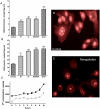Mangafodipir protects against hepatic ischemia-reperfusion injury in mice
- PMID: 22073237
- PMCID: PMC3206884
- DOI: 10.1371/journal.pone.0027005
Mangafodipir protects against hepatic ischemia-reperfusion injury in mice
Abstract
Introduction and aim: Mangafodipir is a contrast agent used in magnetic resonance imaging that concentrates in the liver and displays pleiotropic antioxidant properties. Since reactive oxygen species are involved in ischemia-reperfusion damages, we hypothesized that the use of mangafodipir could prevent liver lesions in a mouse model of hepatic ischemia reperfusion injury. Mangafodipir (MnDPDP) was compared to ischemic preconditioning and intermittent inflow occlusion for the prevention of hepatic ischemia-reperfusion injury in the mouse.
Methods: Mice were subjected to 70% hepatic ischemia (continuous ischemia) for 90 min. Thirty minutes before the ischemic period, either mangafodipir (10 mg/kg) or saline was injected intraperitoneally. Those experimental groups were compared with one group of mice preconditioned by 10 minutes' ischemia followed by 15 minutes' reperfusion, and one group with intermittent inflow occlusion. Hepatic ischemia-reperfusion injury was evaluated by measurement of serum levels of aspartate aminotransferase (ASAT) activity, histologic analysis of the livers, and determination of hepatocyte apoptosis (cytochrome c release, caspase 3 activity). The effect of mangafodipir on the survival rate of mice was studied in a model of total hepatic ischemia.
Results: Mangafodipir prevented experimental hepatic ischemia-reperfusion injuries in the mouse as indicated by a reduction in serum ASAT activity (P<0.01), in liver tissue damages, in markers of apoptosis (P<0.01), and by higher rates of survival in treated than in untreated animals (P<0.001). The level of protection by mangafodipir was similar to that observed following intermittent inflow occlusion and higher than after ischemic preconditioning.
Conclusions: Mangafodipir is a potential new preventive treatment for hepatic ischemia-reperfusion injury.
Conflict of interest statement
Figures





Similar articles
-
Pretreatment with mangafodipir improves liver graft tolerance to ischemia/reperfusion injury in rat.PLoS One. 2012;7(11):e50235. doi: 10.1371/journal.pone.0050235. Epub 2012 Nov 30. PLoS One. 2012. PMID: 23226251 Free PMC article.
-
Comparison of ischemic preconditioning and intermittent and continuous inflow occlusion in the murine liver.Ann Surg. 2002 Mar;235(3):400-7. doi: 10.1097/00000658-200203000-00012. Ann Surg. 2002. PMID: 11882762 Free PMC article.
-
Ischemic preconditioning attenuates morphological and biochemical changes in hepatic ischemia/reperfusion in rats.Pathobiology. 2010;77(3):136-46. doi: 10.1159/000292647. Epub 2010 May 28. Pathobiology. 2010. PMID: 20516729
-
Current strategies to minimize hepatic ischemia-reperfusion injury by targeting reactive oxygen species.Transplant Rev (Orlando). 2012 Apr;26(2):103-14. doi: 10.1016/j.trre.2011.10.006. Transplant Rev (Orlando). 2012. PMID: 22459037 Free PMC article. Review.
-
Ischemic preconditioning in hepatic ischemia and reperfusion.Curr Opin Organ Transplant. 2008 Apr;13(2):142-7. doi: 10.1097/MOT.0b013e3282f6a164. Curr Opin Organ Transplant. 2008. PMID: 18685294 Review.
Cited by
-
Pretreatment with mangafodipir improves liver graft tolerance to ischemia/reperfusion injury in rat.PLoS One. 2012;7(11):e50235. doi: 10.1371/journal.pone.0050235. Epub 2012 Nov 30. PLoS One. 2012. PMID: 23226251 Free PMC article.
-
MnSOD Mimetics in Therapy: Exploring Their Role in Combating Oxidative Stress-Related Diseases.Antioxidants (Basel). 2024 Nov 23;13(12):1444. doi: 10.3390/antiox13121444. Antioxidants (Basel). 2024. PMID: 39765773 Free PMC article. Review.
-
Use of a hanging-weight system for liver ischemia in mice.J Vis Exp. 2012 Aug 7;(66):e2550. doi: 10.3791/2550. J Vis Exp. 2012. PMID: 22895458 Free PMC article.
-
Treatment of oxaliplatin-induced peripheral neuropathy by intravenous mangafodipir.J Clin Invest. 2014 Jan;124(1):262-72. doi: 10.1172/JCI68730. Epub 2013 Dec 20. J Clin Invest. 2014. PMID: 24355920 Free PMC article. Clinical Trial.
-
Protective effects of mangafodipir against chemotherapy-induced ovarian damage in mice.Reprod Biol Endocrinol. 2018 Oct 27;16(1):106. doi: 10.1186/s12958-018-0426-y. Reprod Biol Endocrinol. 2018. PMID: 30368246 Free PMC article.
References
-
- Gozzetti G, Mazziotti A, Grazi GL, Jovine E, Gallucci A, et al. Liver resection without blood transfusion. Br J Surg. 1995;82:1105–1110. - PubMed
-
- Matsumata T, Ikeda Y, Hayashi H, Kamakura T, Taketomi A, et al. The association between transfusion and cancer-free survival after curative resection for hepatocellular carcinoma. Cancer. 1993;72:1866–1871. - PubMed
-
- Nagasue N, Uchida M, Kubota H, Hayashi T, Kohno H, et al. Cirrhotic livers can tolerate 30 minutes ischaemia at normal environmental temperature. Eur J Surg. 1995;161:181–186. - PubMed
-
- Makuuchi M, Mori T, Gunven P, Yamazaki S, Hasegawa H. Safety of hemihepatic vascular occlusion during resection of the liver. Surg Gynecol Obstet. 1987;164:155–158. - PubMed
Publication types
MeSH terms
Substances
LinkOut - more resources
Full Text Sources
Other Literature Sources
Research Materials

